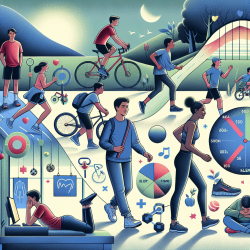Introduction
In the ever-evolving landscape of adolescent health, practitioners are continually seeking evidence-based strategies to enhance outcomes. A recent study titled "Outdoor physical activity, compliance with the physical activity, screen time, and sleep duration recommendations, and excess weight among adolescents" provides critical insights into how outdoor physical activity can be a pivotal factor in promoting healthier lifestyles among adolescents. This blog explores the key findings of the study and offers practical recommendations for practitioners to implement these insights effectively.
Key Findings from the Study
The study, conducted by Sampasa-Kanyinga et al., involved 10,028 middle and high school students, with a mean age of 15.2 years. The research focused on the relationships between outdoor physical activity after school, compliance with physical activity, screen time, and sleep duration recommendations, and the prevalence of overweight/obesity among adolescents.
The study's findings revealed:
- A positive correlation between the number of weekdays spent engaging in outdoor physical activity after school and compliance with physical activity (≥60 minutes/day of moderate-to-vigorous intensity) and screen time (≤2 hours/day) recommendations.
- A negative correlation between outdoor physical activity and overweight/obesity, indicating that increased outdoor activity may help reduce excess weight.
- Significant sex differences in adherence to sleep duration and physical activity recommendations, with males showing greater compliance when engaged in outdoor activities.
Practical Recommendations for Practitioners
Based on these findings, practitioners can adopt the following strategies to enhance adolescent health outcomes:
- Promote Outdoor Activities: Encourage schools and parents to facilitate outdoor physical activities after school. This can include organized sports, outdoor games, or simply encouraging free play in safe environments.
- Monitor Screen Time: Educate adolescents and their guardians about the importance of limiting screen time to no more than two hours per day. Provide resources and strategies to help manage and reduce screen exposure.
- Tailor Interventions by Gender: Recognize the gender differences in compliance with health recommendations. Design interventions that cater to the specific needs and preferences of both male and female adolescents.
- Integrate Sleep Education: Highlight the importance of adequate sleep as part of a holistic approach to health. Encourage routines that promote better sleep hygiene, particularly for males who may benefit more from outdoor activities.
Encouraging Further Research
While the study provides valuable insights, it also opens avenues for further research. Practitioners are encouraged to explore the following areas:
- Investigate the long-term impact of outdoor physical activity on adolescent health outcomes.
- Examine the role of environmental and social factors in facilitating or hindering outdoor activities.
- Study the effectiveness of different types of outdoor activities in promoting health and well-being.
By embracing these research opportunities, practitioners can contribute to a deeper understanding of how to optimize adolescent health through outdoor activities.
Conclusion
The study by Sampasa-Kanyinga et al. underscores the significant role that outdoor physical activity can play in improving adolescent health. By implementing the study's findings and encouraging further research, practitioners can make data-driven decisions that foster healthier lifestyles for young individuals.
To read the original research paper, please follow this link: Outdoor physical activity, compliance with the physical activity, screen time, and sleep duration recommendations, and excess weight among adolescents.










